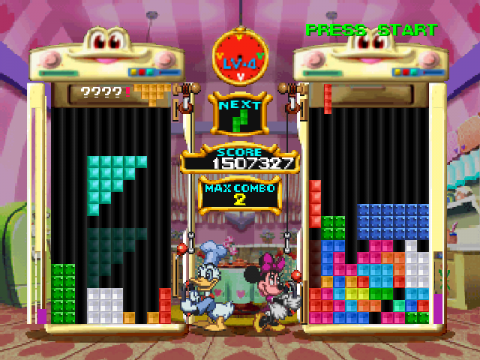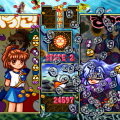- Lucky Dime Caper Starring Donald Duck, The
- Deep Duck Trouble Starring Donald Duck
- Quackshot Starring Donald Duck
- World of Illusion Starring Mickey Mouse and Donald Duck
- Donald Duck no Mahou no Boushi
- Magical Quest 3 Starring Mickey and Donald
- Maui Mallard in Cold Shadow
- Magical Tetris Challenge
- Donald Duck: Goin’ Quackers
What do you get if you combine the legendary puzzle game Tetris with the legendary cast of characters from Disney? Obviously, you get a Tetris game with Disney characters, and that was exactly what Capcom set out to make in 1998 with their arcade release Magical Tetris Challenge. Most Tetris titles up until this time put emphasis on the endless mode where players would have to keep their minds sharp for as long as possible with increasing speeds, but Capcom decided to focus more on the competitive side of Tetris. As such, the game features some similarities to their signature puzzle title, Super Puzzle Fighter II Turbo. The game was designed by Hidemaro Fujibayashi, who would eventually go on to direct several of the handheld Zelda titles.
Even though the game features an ensemble cast of Disney’s most famous stars, the story mode is told through the eyes of the chosen character, one of which is Donald Duck. His story in this game begins with a quiet fishing trip which becomes extraordinary when he gets a mysterious stone on the hook. The stone has a strange alluring glow to it, and Donald can’t figure out what or where it is from. He decides to seek out his friends Goofy, Mickey and Minnie to hear their take on it. Mickey suspects the stone is not of this world, so Donald decides to keep it and make an amulet out of it. Word gets out on the streets however, and it seems Big Pete would love to get his hands on Donald’s stone.
Story mode is played through a small series of cutscenes which results in two characters going at it in a match of Tetris. The Tetris fights are often substitutes for other actions, like on Minnie’s stage the two dueling block constructors are actually baking a cake. It’s pretty much the familiar Tetris which most people around the world is familiar with, but the game adds some new “Magical” blocks to spice up the competetiveness. Achieving Tetris (four complete lines) and stringing together combo chains of cleared lines will drop these magical blocks in the queue of the opponents window, and once they fall, they are bound to have some trouble on their hands. The magical blocks are built up by pentomino, blocks strung together by the edge, and they can also be large steel blocks and other exclusive shapes. The biggest new addition is the 5x blocks, which with the right strategy, can trigger a Pentris.
Every line cleared also fills up a new magical meter, which when filled up, will shake the Tetris board to align the blocks and wash away 75% of it. Due to the Disney tie-in the game is geared more towards younger and novice players, and all blocks have a shadow which shows the player where it will land before doing so, giving them some added foresight and allowing for easier reaction and strategizing. The difficulty can still be ramped up for single players, but the AI isn’t the greatest, giving Magical Tetris Challenge a reputation for being a bit too easy.
There are other modes such as Classic and Upside-down Tetris. The latter is a purely competitive mode where every two or more lines cleared will push the other player’s field up accordingly, with a space left in so that they can have a chance to even the score and lower their unwelcome lines. Whenever lines are cleared or other events happen of both good and bad nature, the small sprite character will act and react to them, much like in Capcom’s Puzzle Fighter series. Each stage dresses the characters up in different costumes relative to the background setting.
Even though graphics are hardly a selling point for a Tetris game, Magical Tetris Challenge might be the most visually appealing Tetris game to date, next to Tetris DS by Nintendo. The sprite work is pleasing and appropriate as one would expect from the 2D masters at Capcom, and their reactions are always entertaining to watch, especially Donald’s many gestures and expressions. The cut scenes feature a mix of sprite work and full sized static illustration. The visuals can also be a bit distracting when things speed up though, since there is a lot of movement going on.
Intermediate and expert players of Tetris will probably prefer a more serious and traditional form of Tetris rather than play around with this cutesy version, with its new magical blocks and shadows. But for players who often get massacred within seconds, it’s a refreshing experience to actually be able to sit down and manage to win some light spirited matches. It has everything it needs to be a Tetris game, and it manages to capture a lot of the charm in Disney and their signature style of humor and good heart.
A Game Boy Color version was released one year after the Arcade and home console ports, and differs slightly in content and modes. The biggest new addition is the Quest Mode, which replaces the story mode with an all new RPG style overworld where the players can walk around and challenge familiar faces from the Disney universe to a game of Tetris. There are also three exclusive Tetris modes, Signal, Towering and Target Tetris. In Signal Tetris, you are given a row of colors at the bottom which must match colors with the regular row. To change the color, lines must be cleared, and the last block you cleared the line with will change color. The higher the difficulty the more colors there will be. Towering Tetris starts the game with blocks scattered, and the objective is to clear the the lines before the scattered blocks rises up. This mode features an exclusive piece which can shoot single square blocks out for a limited time. Target Tetris requires players to clear a preset number of blocks which must be cleared with a limited number of pieces, much like the Puzzle Mode in Tetris DS.
Costumes


